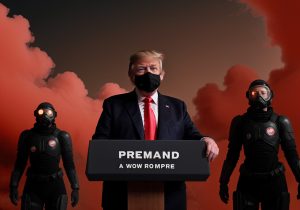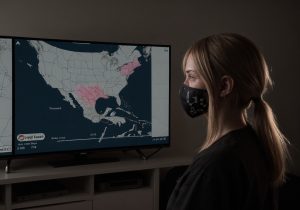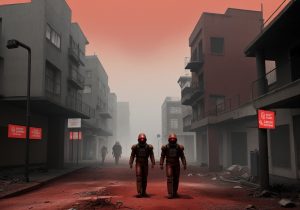You’ve been searching for an alternative ever since kratom was banned at the federal level in 2027, courtesy of Donald Trump’s aggressive escalation of the war on drugs. As a long-time kratom user, you’ve heard whispers about something else—a powerful substitute being used by locals in the remote jungles near Parque Nacional Patuca, Honduras. They call it “red dust.” The rumors seem almost too good to be true, but you’re desperate. You board a plane, leave everything behind, and set off on an adventure you hope will help you regain the balance in your life. The red dust fungi offer relief, and for the first few days, you feel at peace. But that peace is short-lived.
Scenario Description:
The first few days of your trip are filled with excitement. The remote jungles are beautiful, and the red dust fungi have a strange allure—its effects are reminiscent of kratom, calming your mind and relaxing your body. The locals, friendly and welcoming, share their knowledge and traditions with you. But there’s something else they offer: the Goddess Strain, a particularly potent form of red dust that only the bravest of them consume as a rite of passage. You’re intrigued, maybe even a little reckless, and so, when they challenge you to try it, you accept.
The experience is unlike anything you’ve ever felt before—frightening and exhilarating, a high that pushes the boundaries of your mind. You feel connected to something primal, a deep force within the earth. But when you wake up the next morning, something’s wrong. You brush it off, attributing it to exhaustion from your journey. Little do you know, you’ve just crossed into a nightmare.
The Outbreak:
A few days after consuming the Goddess Strain, your body begins to fail you. It starts with skin lesions, then comes the joint pain—so intense it feels like fire in your bones. You’re sweating through anxiety attacks, and the inflammation spreading through your body brings you to the hospital. But even the doctors are at a loss. You deteriorate fast, abscesses forming on your skin, until the abscesses burst, releasing an eerie, crimson dust.
Military personnel patrol the streets, curfews are imposed, and the air itself becomes the enemy as weather reports begin tracking spore levels instead of pollen.
You’re not the only one. Within days, hospitals start filling with people reporting the same symptoms. The red dust is confirmed to be fungal spores—an unknown strain with no clear origin. It spreads rapidly, first in Honduras, then in nearby regions, and before long, cases appear across the US. The fungal infection, now named the Red Dust Plague, is making headlines worldwide.
The Rapid Collapse:
You’re lucky—you survive the infection, though not without lasting pain and fatigue. But many others aren’t so fortunate. The red dust spreads quickly, both through human-to-human contact and by airborne spores, capable of traveling great distances. Skin lesions become necrotic for some, while others develop motor neuron diseases, leaving them immobile or worse—dead. The infection brings about horrific symptoms: unbearable joint and muscle pain, abscesses, anxiety attacks, and for some, catastrophic weight loss, bringing their bodies down to a BMI of 16 or lower.

Healthcare systems are overwhelmed. The US enacts Project BioShield, a protocol designed for biological catastrophes like Soviet-era bioweapons or smallpox, and suddenly, the entire nation is under strict lockdown. Military personnel patrol the streets, curfews are imposed, and the air itself becomes the enemy as weather reports begin tracking spore levels instead of pollen. Air filters become a necessity, and those who can’t access them face terrifying odds: a mortality rate as high as 40% for those without treatment.

Even those who survive aren’t the same. The fungus has a strange psychoactive effect, often triggering prolonged anxiety attacks that leave its victims mentally and emotionally wrecked. Many of the infected suffer from fibromyalgia long after they’ve recovered from the initial infection, and some are left permanently debilitated by chronic pain.
Global Counter-Measures:
In a desperate attempt to slow the spread of the Red Dust spores, governments across the world authorize a controversial countermeasure: airplanes releasing antifungal aerosols on a global scale. The aerosols work to dramatically reduce the atmospheric load of spores, cutting infections by nearly half for a short time. However, the process is far from perfect. The aerosols come with steep environmental costs, disrupting local ecosystems and weather patterns. Due to these adverse effects—and the extreme expense of the operation—the global community agrees that the antifungal release can only be used twice.
The temporary respite buys the world precious time, but the Red Dust continues to spread once the aerosols dissipate, and the infections rise again.
Meanwhile, researchers race to develop a long-term treatment. They discover that the indigenous tribe in Honduras, whose members have used the red dust fungi for centuries, appear to be immune to most of its deadly effects. Scientists isolate polyclonal antibodies from the tribe, which become the basis for a promising treatment. However, the process of researching, manufacturing, and distributing the antibody treatment takes time—too much time.
The Human Toll:

By the time the antibody treatment is ready for mass distribution, the world has already been ravaged by the Red Dust Plague. Healthcare systems in many countries have collapsed, and entire regions are left devastated by the fungus’s relentless spread. The final death toll is staggering, with between 200 to 400 million lives lost across the globe.
The survivors, though spared the worst of the disease, are left to contend with its long-term effects. Many suffer from chronic pain, psychological trauma, and permanent physical disabilities. Society is forever changed as entire cities are abandoned, and the survivors struggle to rebuild a world that bears the scars of the most devastating fungal pandemic in history.
Mitigation and Survival:
With no cure in sight, governments worldwide focus on mitigation. Biohazard suits, extreme quarantines, and air filtration systems become standard, and yet the threat of infection lingers in every breath of air. The fungus doesn’t just target the body—it plays with the mind, triggering waves of anxiety and paranoia that sweep through communities already at the breaking point. Survivors bear the weight of physical and psychological trauma, with many living in fear that the spores will mutate once more and strike again.
In the US, the pain becomes so intense for some that strong painkillers are in constant demand, though even the best treatment only dampens the agony. For those hit hardest by the disease, recovery is long and uncertain. Entire cities are transformed into ghost towns, left deserted as the airborne spores continue to linger in the atmosphere.
The antifungal aerosols released by planes provide temporary relief, dramatically reducing infections for a short period but leaving long-lasting environmental damage. Due to the steep costs and ecological impact, this countermeasure can only be used twice. Meanwhile, the development of the polyclonal antibody treatment from the immune tribe in Honduras takes months to distribute, but it offers hope for those still fighting the infection.
By the time the pandemic is declared over, the world has lost an estimated 200 to 400 million people. The survivors are left to pick up the pieces of a world forever changed—one where every breath feels like a risk, and the shadows of the Red Dust Plague linger in both body and mind.

